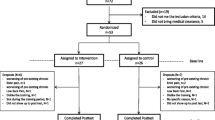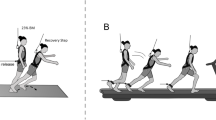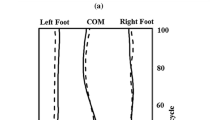Abstract
Impaired balance and gait performance increase fall-risk in seniors. Acute effects of different exercise bouts on gait and balance were not yet addressed. Therefore, 19 healthy seniors (10 women, 9 men, age: 64.6 ± 3.2 years) were examined on 3 days. After exhaustive treadmill testing, participants randomly completed a 2-km treadmill walking test (76 ± 8 % VO2max) and a resting control condition. Standing balance performance (SBALP) was assessed by single limb-eyes opened (SLEO) and double limb-eyes closed (DLEC) stance. Gait parameters were collected at comfortable walking velocity. A condition × time interaction of center of pressure path length (COPpath) was observed for both balance tasks (p < 0.001). Small (Cohen’s d = 0.42, p = 0.05) and large (d = 1.04, p < 0.001) COPpath increases were found after 2-km and maximal exercise during DLEC. Regarding SLEO, slightly increased COPpath occurred after 2-km walking (d = 0.29, p = 0.65) and large increases after exhaustive exercise (d = 1.24, p < 0.001). No significant differences were found for gait parameters. Alterations of SBALP after exhaustive exercise might lead to higher fall-risk in seniors. Balance changes upon 2-km testing might be of minor relevance. Gait is not affected during single task walking at given velocities.

Similar content being viewed by others
References
Abrahamova D, Hlavacka F (2008) Age-related changes of human balance during quiet stance. Physiol Res 57(6):957–964
Chapman GJ, Hollands MA (2006a) Age-related differences in step** performance during step cycle-related removal of vision. Exp Brain Res 174(4):613–621
Chapman GJ, Hollands MA (2006b) Evidence for a link between changes to gaze behaviour and risk of falling in older adults during adaptive locomotion. Gait Posture 24(3):288–294
Charles C, Cian C, Nougier V, Bigard XA, Job A, Raphel C (2002) Over-stimulation of the vestibular system and body balance. J Vestib Res 12(2–3):135–143
Clark RA, Bryant AL, Pua Y, McCrory P, Bennell K, Hunt M (2010) Validity and reliability of the Nintendo Wii Balance Board for assessment of standing balance. Gait Posture 31(3):307–310
Cohen J (1992) A power primer. Psychol Bull 112(1):155–159
Colledge NR, Cantley P, Peaston I, Brash H, Lewis S, Wilson JA (1994) Ageing and balance: the measurement of spontaneous sway by posturography. Gerontology 40(5):273–278
Coren S (1993) The lateral preference inventory for measurement of handedness, footedness, eyedness, and earedness: norms for young adults. Bull Psychon Soc 31(1):1–3
de Menezes RL, Bachion MM (2008) Study of intrinsic risk factors for falls in institutionalized elderly people. Cien Saude Colet 13(4):1209–1218
Fox ZG, Mihalik JP, Blackburn JT, Battaglini CL, Guskiewicz KM (2008) Return of postural control to baseline after anaerobic and aerobic exercise protocols. J Athl Train 43(5):456–463
Frey I, Berg A, Grathwohl D, Keul J (1999) Freiburg questionnaire of physical activity—development, evaluation and application. Soz Praventivmed 44(2):55–64
Gauchard GC, Gangloff P, Vouriot A, Mallie JP, Perrin PP (2002) Effects of exercise-induced fatigue with and without hydration on static postural control in adult human subjects. Int J Neurosci 112(10):1191–1206
Granacher U, Gruber M, Gollhofer A (2010a) Force production capacity and functional reflex activity in young and elderly men. Aging Clin Exp Res 22(5–6):374–382
Granacher U, Iten N, Roth R, Gollhofer A (2010b) Slackline training for balance and strength promotion. Int J Sports Med 31(10):717–723
Granacher U, Bridenbaugh SA, Muehlbauer T, Wehrle A, Kressig RW (2011a) Age-related effects on postural control under multi-task conditions. Gerontology 57(3):247–255
Granacher U, Muehlbauer T, Zahner L, Gollhofer A, Kressig RW (2011b) Comparison of traditional and recent approaches in the promotion of balance and strength in older adults. Sports Med 41(5):377–400
Hauer K, Rost B, Rutschle K, Opitz H, Specht N, Bartsch P, Oster P, Schlierf G (2001) Exercise training for rehabilitation and secondary prevention of falls in geriatric patients with a history of injurious falls. J Am Geriatr Soc 49(1):10–20
Hauer K, Becker C, Lindemann U, Beyer N (2006) Effectiveness of physical training on motor performance and fall prevention in cognitively impaired older persons: a systematic review. Am J Phys Med Rehabil 85(10):847–857
Helbostad JL, Leirfall S, Moe-Nilssen R, Sletvold O (2007) Physical fatigue affects gait characteristics in older persons. J Gerontol A Biol Sci Med Sci 62(9):1010–1015
Helbostad JL, Sturnieks DL, Menant J, Delbaere K, Lord SR, Pijnappels M (2010a) Consequences of lower extremity and trunk muscle fatigue on balance and functional tasks in older people: a systematic literature review. BMC Geriatr 10:56
Helbostad JL, Taraldsen K, Granbo R, Yardley L, Todd CJ, Sletvold O (2010b) Validation of the falls efficacy scale-international in fall-prone older persons. Age Ageing 39(2):259
Kemi OJ, Wisloff U (2010) High-intensity aerobic exercise training improves the heart in health and disease. J Cardiopulm Rehabil Prev 30(1):2–11
Kressig RW, Herrmann FR, Grandjean R, Michel JP, Beauchet O (2008) Gait variability while dual-tasking: fall predictor in older inpatients? Aging Clin Exp Res 20(2):123–130
Lepers R, Bigard AX, Diard JP, Gouteyron JF, Guezennec CY (1997) Posture control after prolonged exercise. Eur J Appl Physiol Occup Physiol 76(1):55–61
Lutz W, Sanderson W, Scherbov S (2008) The coming acceleration of global population ageing. Nature 451(7179):716–719
Middleton J, Sinclair P, Patton R (1999) Accuracy of centre of pressure measurement using a piezoelectric force platform. Clin Biomech (Bristol, Avon) 14(5):357–360
Midgley AW, McNaughton LR, Polman R, Marchant D (2007) Criteria for determination of maximal oxygen uptake: a brief critique and recommendations for future research. Sports Med 37(12):1019–1028
Nardone A, Tarantola J, Giordano A, Schieppati M (1997) Fatigue effects on body balance. Electroencephalogr Clin Neurophysiol 105(4):309–320
Oja P, Laukkanen R, Pasanen M, Tyry T, Vuori I (1991) A 2-km walking test for assessing the cardiorespiratory fitness of healthy adults. Int J Sports Med 12(4):356–362
Owings TM, Grabiner MD (2003) Measuring step kinematic variability on an instrumented treadmill: how many steps are enough? J Biomech 36(8):1215–1218
Parijat P, Lockhart TE (2008) Effects of lower extremity muscle fatigue on the outcomes of slip-induced falls. Ergonomics 51(12):1873–1884
Peterson MJ, Pieper CF, Morey MC (2003) Accuracy of VO2(max) prediction equations in older adults. Med Sci Sports Exerc 35(1):145–149
Riskowski JL, Mikesky AE, Bahamonde RE, Alvey TV 3rd, Burr DB (2005) Proprioception, gait kinematics, and rate of loading during walking: are they related? J Musculoskelet Neuronal Interact 5(4):379–387
Rubenstein LZ (2006) Falls in older people: epidemiology, risk factors and strategies for prevention. Age Ageing 35(Suppl 2):37–41
Salavati M, Hadian MR, Mazaheri M, Negahban H, Ebrahimi I, Talebian S, Jafari AH, Sanjari MA, Sohani SM, Parnianpour M (2009) Test-retest reliability of center of pressure measures of postural stability during quiet standing in a group with musculoskeletal disorders consisting of low back pain, anterior cruciate ligament injury and functional ankle instability. Gait Posture 29(3):460–464
Schmid M, Conforto S, Bibbo D, D’Alessio T (2004) Respiration and postural sway: detection of phase synchronizations and interactions. Hum Mov Sci 23(2):105–119
Stevens JA, Corso PS, Finkelstein EA, Miller TR (2006) The costs of fatal and non-fatal falls among older adults. Inj Prev 12(5):290–295
Trombetti A, Hars M, Herrmann FR, Kressig RW, Ferrari S, Rizzoli R (2011) Effect of music-based multitask training on gait, balance, and fall risk in elderly people: a randomized controlled trial. Arch Intern Med 171(6):525–533
Acknowledgments
The authors would like to appreciate the engagement of the subjects during the study. Additional thank is dedicated to the ProSenectute society (Basel, Switzerland) who supported the acquisition of the included subjects.
Conflict of interest
None declared.
Author information
Authors and Affiliations
Corresponding author
Additional information
Communicated by Fausto Baldissera.
Rights and permissions
About this article
Cite this article
Donath, L., Zahner, L., Roth, R. et al. Balance and gait performance after maximal and submaximal endurance exercise in seniors: is there a higher fall-risk?. Eur J Appl Physiol 113, 661–669 (2013). https://doi.org/10.1007/s00421-012-2471-0
Received:
Accepted:
Published:
Issue Date:
DOI: https://doi.org/10.1007/s00421-012-2471-0




